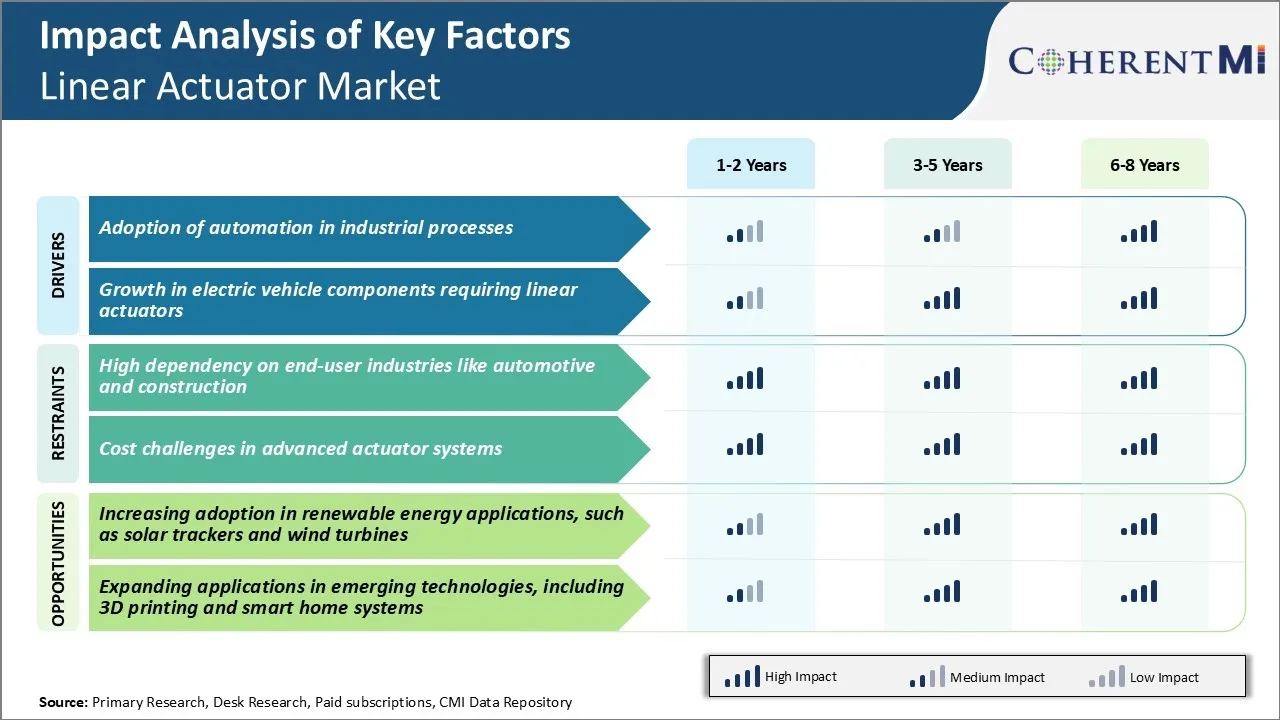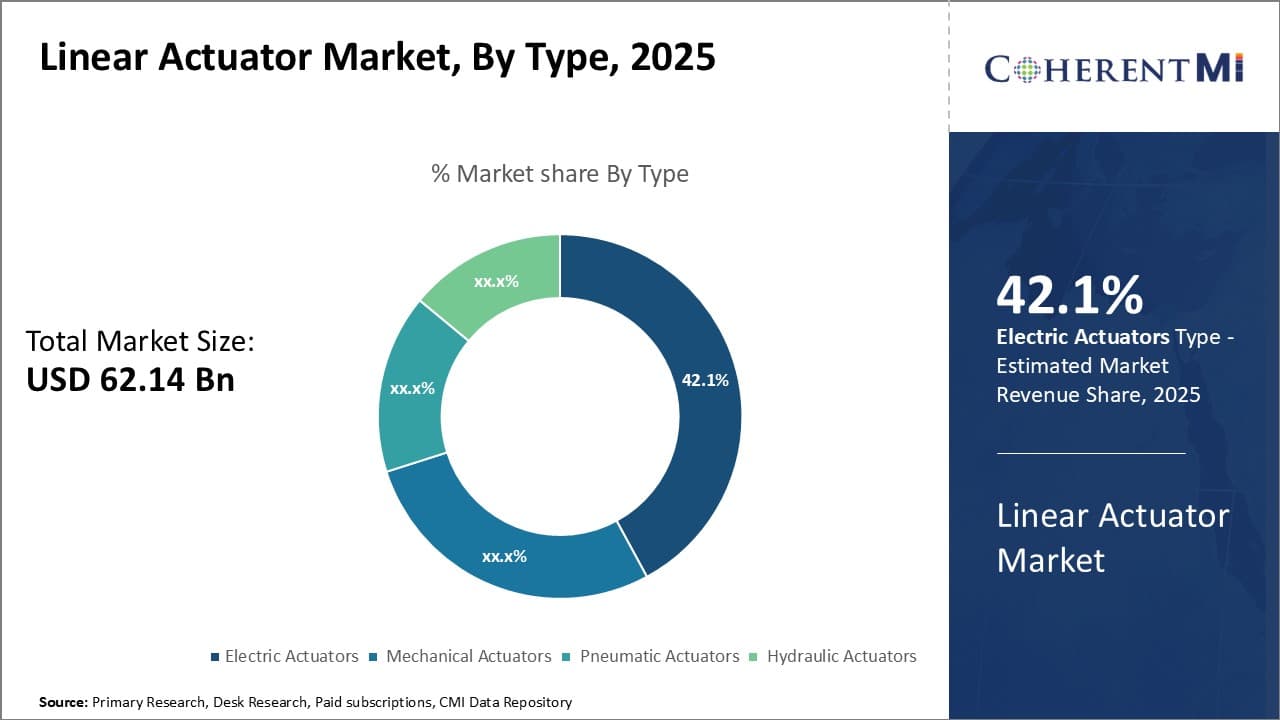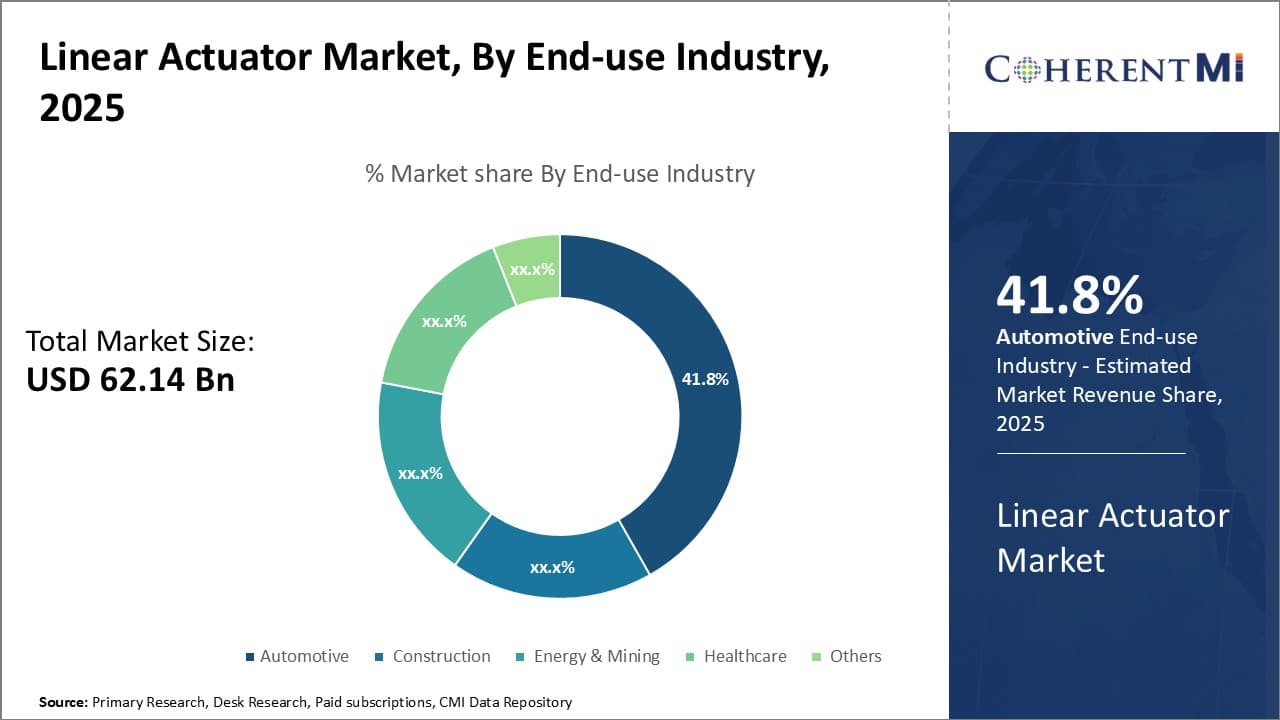

The linear actuator market is estimated to be valued at USD 62.14 Bn in 2025 and is expected to reach USD 106.50 Bn by 2032. It is estimated to grow at a compound annual growth rate (CAGR) of 8.00% from 2025 to 2032. Growth of the linear actuator market is driven by increasing adoption of linear motion technologies across industries such as automotive, medical, aviation, and more.
Market Size in USD Bn
CAGR8.00%
| Study Period | 2025-2032 |
| Base Year of Estimation | 2024 |
| CAGR | 8.00% |
| Market Concentration | Medium |
| Major Players | Bosch Rexroth AG, Emerson Electric Co., HepcoMotion Ltd., Kollmorgen Corporation, LINAK A/S and Among Others |
Market Driver - Adoption of Automation in Industrial Processes
The manufacturing sector has seen significant changes over the past few decades driven by the need to improve productivity and reduce costs. One of the major trends helping achieve these goals has been the increasing adoption of automation technologies across various industrial processes.
Linear actuators provide precise positioning and control over motion which is critical for automated assembly and material handling applications. Their compact sizes allow more flexibility in machine design compared to cylinders. For operations dealing with fragile components or requiring minimal variation, linear actuators deliver the accuracy that pneumatics cannot match.
With Industry 4.0 trends like smart factories gaining momentum, linear actuators are enabling integration of IIoT sensors gathering real-time production data. Self-diagnosing actuators can also predict maintenance needs remotely. This transition towards intelligent automation bodes well for the growth of the linear actuator market.
Market Driver - Growth in Electric Vehicle Components Requiring Linear Actuators
Rising environmental concerns have accelerated shifts towards more sustainable transport solutions. One of the most prominent changes is the fast expanding electric vehicles (EVs) industry worldwide. Adoption of EVs is also spurring growth in other components that help enhance driving range and deliver convenient functionality. An example are linear actuators, which are increasingly used across various EV applications such as active grille shutters, front trunk actuators, and seat adjustment mechanisms.
Linear actuators provide precise control over shutter position and movement speed, maximizing air flow while limiting drag. This supports extended driving ranges per charge, a key factor influencing EV purchases. Besides exterior use, linear actuators are also utilized inside EVs for user- experience features.
As autonomous driving leads to more lounge-like cabin concepts, linear motion will play a greater role in reconfiguring vehicle interiors on demand. Over-the-air upgrades are also pushing demands for network-connected actuators supporting remote operations. Major auto manufacturers are making big investments in developing diverse EV lineups. This escalates demand in the linear actuator market.
 To learn more about this report, Download Free Sample Copy
To learn more about this report, Download Free Sample Copy
Market Challenge - High dependency on end-user industries like automotive and construction
The linear actuator market is highly dependent on the performance of the end-user industries like automotive and construction. Around 35-40% of the total linear actuator demand comes from the automotive industry for applications like bonnets, doors, seats etc. However, the automotive industry is currently facing challenges due to global supply chain disruptions caused by the COVID-19 pandemic and semiconductor chip shortage. This is negatively impacting vehicle production across key regions.
Similarly, the construction industry is also facing headwinds due to rising inflation, interest rate hikes and geopolitical tensions. As linear actuators are consumable products that need regular replacement, any slowdown in the automotive and construction industries inhibits the scope for replacement demand. High correlation of demand with cyclical end-user industries poses a challenge for medium to long-term capacity planning for linear actuator market players.
Market Opportunity - Increasing Adoption in Renewable Energy Applications, such as Solar Trackers and Wind Turbines
The global transition towards cleaner energy presents a substantial opportunity for growth in the linear actuator market. Linear actuators are increasingly being used in renewable energy applications such as solar trackers and wind turbines. For instance, solar trackers use linear actuators to adjust the angle of solar panels throughout the day to maximize sunlight exposure.
Similarly, linear actuators play a critical role in pitch control and yaw drive mechanisms in wind turbines. With supportive government policies and technological advancements, the adoption of renewable sources like solar and wind is growing steadily. This provides huge opportunities for linear actuator suppliers to partner with OEMs involved in manufacturing solar tracking systems and wind turbines.
The renewable energy market is expected to grow at over 5% annually through 2030, thus driving the demand for reliable linear actuation solutions. Leveraging this demand can help reduce dependency of linear actuator market on volatile automotive and construction industries.
Focus on product innovation - Linear actuators players have consistently invested in R&D to develop innovative products catering to evolving industry needs.
Expand application coverage - Leading companies have expanded their product offerings to cover diverse applications beyond traditional uses. In 2018, Tolomatic acquired Intelligent Actuator to broaden its portfolio into medical equipment actuators.
Strengthen digital capabilities - With industry 4.0 gaining prominence, players are integrating linear actuators with IoT and cloud. In 2019, SMC Corporation introduced its E1M series electric actuator with built-in IoT functionality.
Pursue acquisitions for growth - Mature players have augmented organic growth through strategic acquisitions, expanding globally. In 2017, Tsubakimoto Chain acquired Servo-Pac, doubling its presence in the North American market.
Focus on emerging economies - Recognizing the shifting market dynamics, players are investing heavily in developing countries through new manufacturing plants, partnership with system integrators. In 2021, IAI opened a new facility in India to complement rising Make-in-India demand for industrial automation components.
 To learn more about this report, Download Free Sample Copy
Insights, By Type: Electric Actuators: A Growing Preference for Automation
To learn more about this report, Download Free Sample Copy
Insights, By Type: Electric Actuators: A Growing Preference for Automation
Electric actuators contribute 42.1% share in the linear actuator market in 2025, owing to their increasing adoption across various industries. With advancements in sensor and control technologies, electric actuators have become smarter and more precise in their operations. Their ease of integration into automated systems has made them popular for applications requiring precision movement and remote operations.
Compared to other types, electric linear actuators offer higher efficiency and finer control over linear motion. The development of low-cost servo motors and variable frequency drives has further boosted the capabilities of electric actuators. Industries are also leveraging embedded networking, analytics, and remote access capabilities of electric actuators to optimize processes on the shop floor in real time. This growing preference for automation driven by technological advances will continue pushing demand for electric actuators in the linear actuator market.
 To learn more about this report, Download Free Sample Copy
To learn more about this report, Download Free Sample Copy
Insights, By End-use Industry: Automotive industry: A Key Growth Driver
The automotive industry accounts for 41.8% share of the linear actuator market in 2025, owing to the widespread use of actuators in vehicles. From adjustable mirrors and window lifts to advanced driver-assistance systems, modern automobiles incorporate dozens of linear actuators to enhance comfort, safety, and performance.
Rising vehicle production driven by the demand for personal mobility worldwide has boosted the use of actuators in automotive applications over the years. Manufacturers in the linear actuator market are also implementing more stringent emission and safety regulations which necessitate the adoption of sophisticated actuator-based automotive systems.
Actuators play a vital role in engine and transmission systems to optimize fuel efficiency and drivability. With increasing vehicle intelligence and automation, the use of actuators is expected to rise further for next-generation assisted and self-driving technologies. As these mega trends disrupt the industry, the automotive sector will continue spearheading growth in the overall linear actuator market.
The major players operating in the linear actuator market include Bosch Rexroth AG, Emerson Electric Co., HepcoMotion Ltd., Kollmorgen Corporation, LINAK A/S, Oriental Motor Co., Ltd., Parker Hannifin Corporation, Rockwell Automation, Inc., SKF Group, ABB Ltd., THK Co. Ltd., Moog Inc., Flowserve Corporation, Altra Industrial Motion Corp., Tolomatic Inc., Duff-Norton, SMC Corporation, IAI America Inc., Warner Linear, Beckhoff Automation GmbH & Co. KG, and Piab AB.
Would you like to explore the option of buying individual sections of this report?
As an accomplished Senior Consultant with 7+ years of experience, Pooja Tayade has a proven track record in devising and implementing data and strategy consulting across various industries. She specializes in market research, competitive analysis, primary insights, and market estimation. She excels in strategic advisory, delivering data-driven insights to help clients navigate market complexities, optimize entry strategies, and achieve sustainable growth.
Linear Actuator Market is segmented By Type (Electric Actuators, Mechanical Actuators, Pneumatic Act...
Linear Actuator Market
How big is the linear actuator market?
The linear actuator market is estimated to be valued at USD 62.14 Bn in 2025 and is expected to reach USD 106.50 Bn by 2032.
What are the key factors hampering the growth of the linear actuator market?
High dependency on end-user industries like automotive and construction and cost challenges in advanced actuator systems are the major factors hampering the growth of the linear actuator market.
What are the major factors driving the linear actuator market growth?
Adoption of automation in industrial processes and growth in electric vehicle components requiring linear actuators are the major factors driving the linear actuator market.
Which is the leading type in the linear actuator market?
The leading type segment is electric actuators.
Which are the major players operating in the linear actuator market?
Bosch Rexroth AG, Emerson Electric Co., HepcoMotion Ltd., Kollmorgen Corporation, LINAK A/S, Oriental Motor Co., Ltd., Parker Hannifin Corporation, Rockwell Automation, Inc., SKF Group, ABB Ltd., THK Co. Ltd., Moog Inc., Flowserve Corporation, Altra Industrial Motion Corp., Tolomatic Inc., Duff-Norton, SMC Corporation, IAI America Inc., Warner Linear, Beckhoff Automation GmbH & Co. KG, and Piab AB are the major players.
What will be the CAGR of the linear actuator market?
The CAGR of the linear actuator market is projected to be 8.00% from 2025-2032.